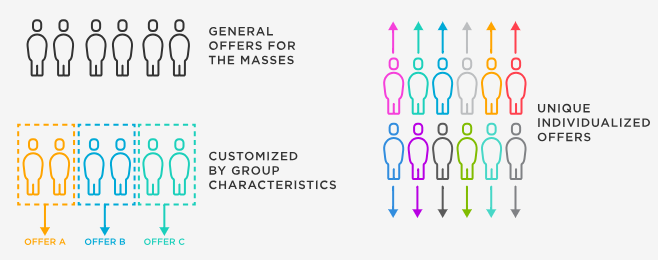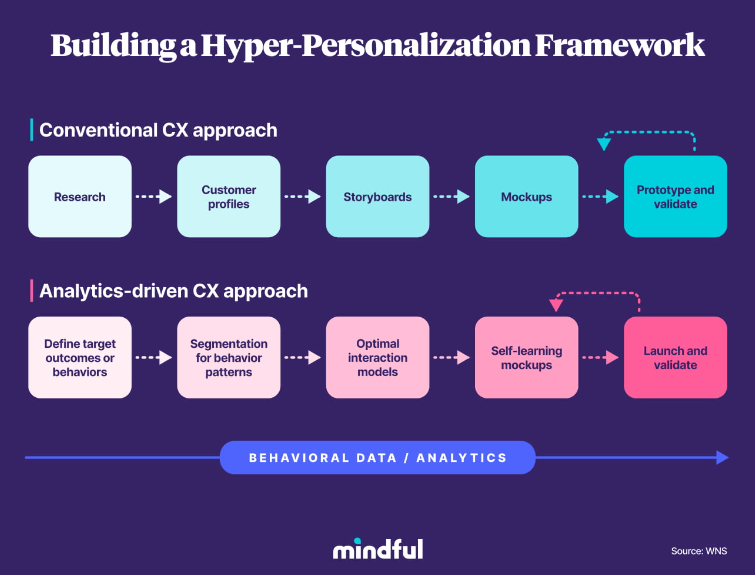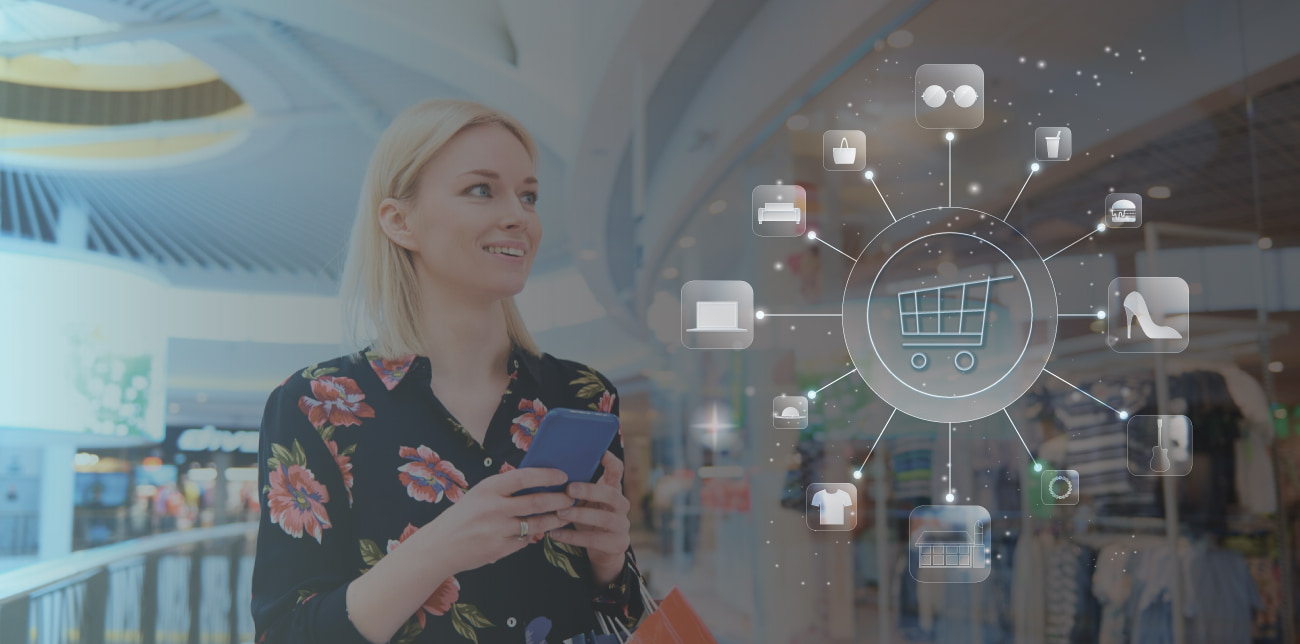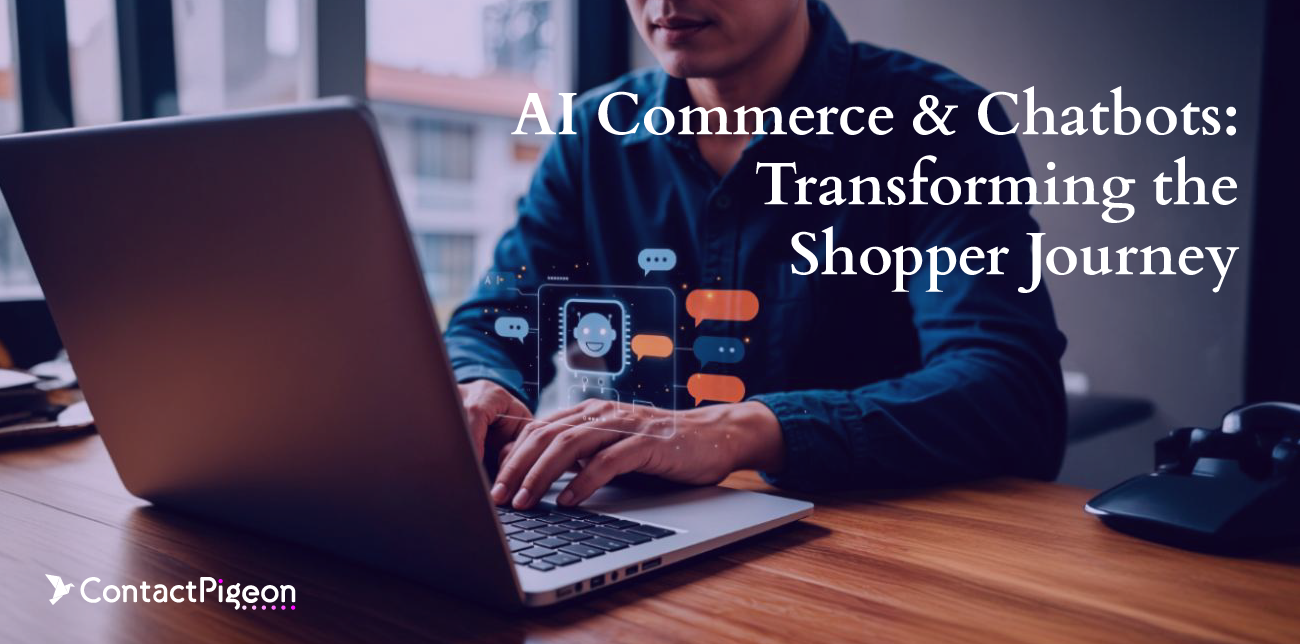Many retailers have already harnessed the power of personalized messaging to attract new customers, but a select few are elevating their game with a strategy known as hyper-personalization in retail marketing. This innovative approach delves deeper into customer interactions, anticipating consumer expectations before they even address them. Hyper-personalization allows retailers to fine-tune their ads and offers to align perfectly with each customer’s unique personality and preferences. By doing so, they aim to cultivate stronger, more profound relationships with potential customers.
For retailers, hyper-personalization in marketing serves as a potent tool for distinguishing themselves in a highly competitive marketplace. It forms an integral part of crafting a tailored customer journey that seamlessly links customers with the products and services they genuinely desire. In the following sections, we’ll delve into the nuances of hyper-personalization and shed light on how this approach operates.
Table of Contents
- > What is hyper-personalization?
- > Traditional personalization vs. hyper-personalization
- > How hyper-personalization works
- > The evolution and significance of retail personalization
- > Important statistics any retailer should know about personalization
- > The benefits of hyper-personalization in retail
- > Implementing hyper-personalization in retail
- > Ethical and technological considerationsl
- > The future of hyper-personalization in retail
- > Insightful resources about hyper-personalization
- > Conclusion and looking forward
What is hyper-personalization?
Today’s customer expects positive interactions with retailers, as 80% of people indicate that experiences are important to them. Hyper-personalization is the most accurate way to tailor the customer journey and modify it specifically for the consumers and their needs, leveraging customer data, analytics, AI, and automations.
Hyper-personalization allows a company to connect with customers and audiences with customized, personal messages. These messages are created to appeal to the right customer in the right context, at the right time, and through the right platform. When done correctly, hyper-personalization lets retailers build a strong rapport with their customers and gain their loyalty.
Traditional personalization vs. hyper-personalization

Personalization involves using historical data to develop marketing strategies and customer experiences based on customers’ demographics and preferences. Hyper-personalization uses real-time data that allows retailers to better customize their marketing messages and customer experiences.
Using traditional personalization, a retailer may send ads for new sneakers to customers who purchased from a certain brand within the past year. Hyper-personalization in retail lets the same company see which customers have been perusing their site for similar shoes and follow up days later with a targeted ad.

How hyper-personalization works
Customer data — including actions taken on websites, apps, and other digital platforms — serves as the foundation of hyper-personalized marketing. Businesses sift through this data using advanced analytics, and machine learning algorithms to find patterns, trends, correlations, and other useful information to drive hyper-personalization.
The evolution and significance of retail personalization
While standard personalization was once an effective way to build customer relationships, it has evolved and shifted with customer expectations.
The evolution of personalization
Personalization started when retailers and other businesses would add personal touches to email blasts and other marketing communications. It could be as simple as including a customer’s name in the opening line or remembering their birthday.
As online shopping started gaining steam, eCommerce companies, including Amazon, would offer personal recommendations to shoppers based on their past shopping history. Throughout the 2010s, technology improvements allowed retailers to display custom website ads to customers and target them on social media and other digital channels based on their interests.
Now, with hyper-personalization, artificial intelligence (AI), and other tools, companies can leverage data to launch ad campaigns specifically geared to customers at specific points of their journey.
Why does hyper-personalization matter in the retail industry?
Marketing to customers who expect a personalized experience is crucial to standing out among the competition. Most customers (71%) expect it from companies. Hyper-personalization in retail can reduce costs to retain customers while vastly improving the customer service experience. As customers come to anticipate these experiences, retailers who don’t adapt risk driving their customers to the competition.
Important statistics any retailer should know about personalization
- 41% of consumers find receiving personalized texts from brands when they walk by a store to be creepy. (Accenture)
- 56% of customers report creepy engagement tactics from banks. (Zippia)
- 80% of customers are more likely to buy from a company offering personalized experiences. (Zippia)
- Companies that have increased their market share by more than 10% annually are spending money on hyper-personalization tools like chatbots. (McKinsey)
- Most customers expect a brand to respond to social media customer service requests within 24 hours. (SproutSocial)
- 76% of customers aren’t happy when a brand does not deliver personalization as expected. (McKinsey)
- 22% of customers don’t mind sharing their data if it results in more personalized service. (Deloitte)
The benefits of hyper-personalization in retail
With customers demanding hyper-personalization in retail, it’s important for retailers to get it right. Connecting with customers in a personal way can offer these benefits.
Enhanced customer experience
Hyper-personalization in retail improves customer experiences by:
- Creating emotional connections: Brands can analyze user behavior to select keywords and imagery in ads that resonate with customers. They can also tailor product suggestions.
- Boosting sales and loyalty: Hyper-personalization tools can make the omnichannel experience seamless. A store can notify a customer when an item they wanted online is available in a nearby store.
- Automating messaging: A brand can automate consumer touchpoints without losing the personal touches that customers have come to expect.
Differentiation in the market
Using hyper-personalization strategies lets retailers stand out by:
- Showing a better understanding of the customer: Using existing customer data, brands can highlight how their product or service is best for the customer based on their needs.
- Reducing decision fatigue: By showcasing hyper-personalized product suggestions, retailers take the weight of decision-making off the customer.
Increased customer loyalty
Retailers can leverage hyper-personalized service models to inspire loyalty by:
- Creating a truly omnichannel experience: Customer behaviors can follow them between channels. Retailers can use customers’ online activity to enhance their in-store experiences and vice versa.
- Building stronger connections: By appealing to customers on a deeper level, retailers can inspire a high level of trust and loyalty.
Increased revenue and profits
Successful companies can tap into hyper-personalization in retail to drive their profits by:
- Reducing costs to keep customers: Hyper-personalization lets retailers optimize marketing budgets by focusing on channels their customers already use.
- Encouraging customers to promote a brand: Personalization makes customers more likely to repurchase and even recommend a brand.
Implementing hyper-personalization in retail

Retailers can implement hyper-personalization strategies in their own businesses by leveraging existing data. They should start by using tools powered by AI to compile and sort the data to give it meaning. Once they have successfully sorted their data, they can look for patterns and preferences that allow them to deliver personalized recommendations to their customers based on real-time information.
This process entails blending technology and data analytics to create messages with a human touch that resonates with current and potential customers. Here is a detailed breakdown of the tools involved.
Data collection and analysis
The first step is to collect and analyze data on customers and their behavior.
- Artificial intelligence and machine learning: AI can sift through piles of data to detect patterns and trends in consumer behavior. AI can also create and adjust customer profiles and detailed personas.
- Big data + advanced AI-driven analytics = hyper-personalization: Today’s retailers have mountains of customer data at their fingertips, so sorting it can get overwhelming. AI helps pull relevant statistics, behavioral patterns, and other crucial data retailers can use to personalize the customer experience.
Real-time personalization strategies
Once a retailer has all the data, they can apply it in multiple ways. Here are some hyper-personalization examples to get started.
Strategy #1: Optimize targeting using geo-fencing
Geo-fencing is a strategy in which a retailer can set up a virtual boundary and send targeted messages to mobile users within that boundary.
Key benefits:
- Allows retailers to deliver timely content
- Gives customers access to limited-time offers when they’re in the area
- Targets customers who are more likely to take advantage of an offer
Strategy #2: Use data analytics to create custom offers
By analyzing behavioral analytics, retailers can send highly targeted, real-time inventory offers to their customers.
Key benefits:
- Allows retailers to develop offers that are more appealing to customers
- Customers are more likely to convert
- Helps retailers stand out from competitors by showing how well they know their customers
Strategy #3: Use dynamic content based on user actions
Instead of creating a singular landing page for every ad campaign, retailers can customize what their customers see based on their actions. Dynamic content lets retailers personalize every part of the customer journey, down to their interactions with the company website.
Key benefits:
- Creates a more engaging customer experience
- Helps decrease bounce rates and increase conversions
Strategy #4: Appeal to specific customer pain points
The data retailers gather when developing hyper-personalized marketing strategies can give them insights into how people may be using their products in unexpected ways. With this information, retailers can create targeted ad campaigns highlighting these uses.
Key benefits:
- Allows a retailer to show that they are paying attention to customer needs
- Gives retailers new resources for upselling and cross-selling
Strategy #5: Use digital insights to tailor the in-person shopping experience

Retailers like Burberry offer tools that give in-store sales associates access to a customer’s shopping history and social media interactions with the brand. With this information, sales associates can customize product recommendations and tailor the in-store shopping trip to a customer’s preferences.
Key benefits:
- Helps retailers create customer experiences that are unique and meaningful
- Allows customers to have a seamless experience online and in person
Ethical and technological considerations
Although hyper-personalized marketing is often successful, customers can perceive it as creepy. They may also be concerned about their privacy. Thankfully, retailers can employ various strategies to avoid these issues.
Privacy, consent, and avoiding “creepiness”
Before contacting any customer, retailers should always get consent. Signing up for messages, push notifications, and text alerts should be easy, and customers should know they are signing up for these lists.
Most importantly, they should be able to opt out, and a retailer should not contact anyone who has opted out of these messages. Retailers can build trust with customers by being transparent about how they are using customer data.
To avoid coming across as “creepy,” retailers should avoid marketing to customers using information that they should not know. For example, hyper-personalization in banking would not be successful if financial institutions tailored offers using exact dollar amounts in consumer accounts.
Technological barriers and solutions
Retailers interested in implementing a hyper-personalization model may face technological barriers. They might not have the right technology to analyze customer data meaningfully or they might not have the human resources to collect and input customer data.
To solve these issues, a retailer can look for a software solution to help them automate certain processes, including customer analysis and client segmentation. They can choose a tool that integrates with their existing website host, social media, and client relationship management platforms to automatically gather existing data.
The future of hyper-personalization in retail

With customers expecting personalized experiences, most retailers will have to adopt hyper-personalization or risk losing business to their competitors. As the trend evolves, retailers can use hyper-personalization strategies to design customized experiences for each customer.
Companies like Sephora are already using hyper-personalization in retail to create unique experiences for each customer. A customer can use their app to book appointments in the store, access a list of products they’ve purchased before, and receive personalized recommendations and coupons.
Sephora uses this data to send personalized emails with specific subject lines to customers based on how they interact with the brand. For example, if a customer searches the website for products containing retinol, they may receive an email in a few days with the word “retinol” strategically placed in the subject line.
As with other digital marketing efforts, hyper-personalization in retail continues to evolve with technology. Retailers can make note of these key trends:
- Brands use social media technology to connect customers to in-store service before they even start shopping. (Read about how Burberry is doing it.)
- Brands use augmented reality in retail to make the shopping experience more inclusive. (Read more about how it works in the education realm.)
- Brands make a stronger commitment to consumer privacy. (Read more about how to keep customer data confidential in the new consumer landscape.)
- Brands anticipate customer needs before customers have even expressed them. (Read more.)
Insightful resources about hyper-personalization
We have rounded up the most insightful information about hyper-personalization in retail to serve as a helpful guide.
Connecting with meaning: Hyper-personalizing the customer experience using data, analytics, and AI (Deloitte)
Key insights:
- Hyper-personalization allows companies to maximize revenue with data-driven marketing.
- Hyper-personalization delivers a customer-centric experience that 90% of customers like.
- Companies should pay attention to hyper-personalization at every step of the customer journey.
- Traditional companies face increased competition from digital-first companies and need hyper-personalization to keep up.
Personalizing the customer experience: Driving differentiation in retail (McKinsey & Company)
Key Insights:
- Personalization extends to the entire customer experience.
- Hyper-personalized marketing lets companies relate to their customers as individuals.
- Companies that nail personalization see 20% higher customer satisfaction rates.
Conclusion and looking forward
As the retail sector continues to evolve, companies that don’t keep up with hyper-personalization in retail may fall behind. Modern customers expect brands to understand them on a deeper level to create personalized offers and experiences. Thus learning how to engage with your audience with hyper-personalization is bound to foster customer trust.
Once a retailer has created a trusting, loyal relationship, they can improve their bottom line by cutting marketing costs to maintain loyal customers. With data-driven marketing strategies and hyper-personalization, brands can focus on their most successful digital channels using messages that are more likely to appeal to target customers. They can also deliver messages at the right time, inspiring customers to buy when they are most likely to do so.
Implementing a hyper-personalized marketing strategy isn’t easy without the right technology. Retailers need to use a platform that integrates with their existing technology to collect and sort through data. ContactPigeon offers solutions that help any eCommerce brand scale with automation and personalization. Our platform was rated one of Europe’s top five marketing automation solutions.
Don’t go it alone. Our solution offers insights into how customers respond to each message, giving retailers valuable information they can use to tweak each message and improve its chances of successfully converting customers. With rich customer profiles and data-driven customer segments, retailers can nail the art of hyper-personalization in retail. Schedule a demo today to learn how we can help you.

Let’s Help You Scale Up





